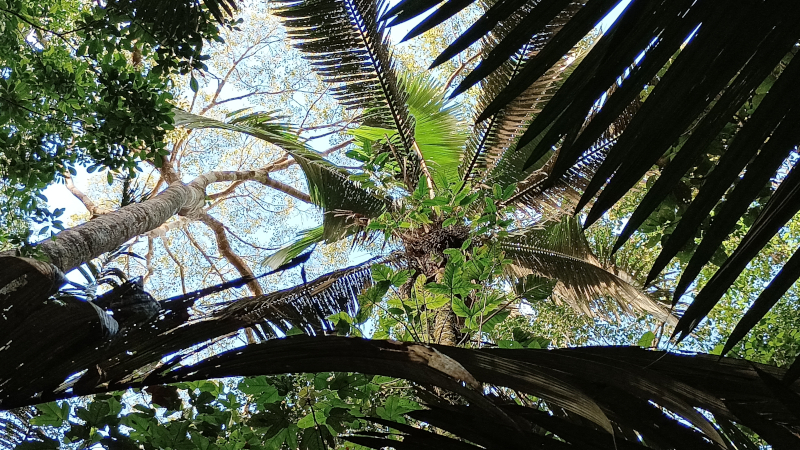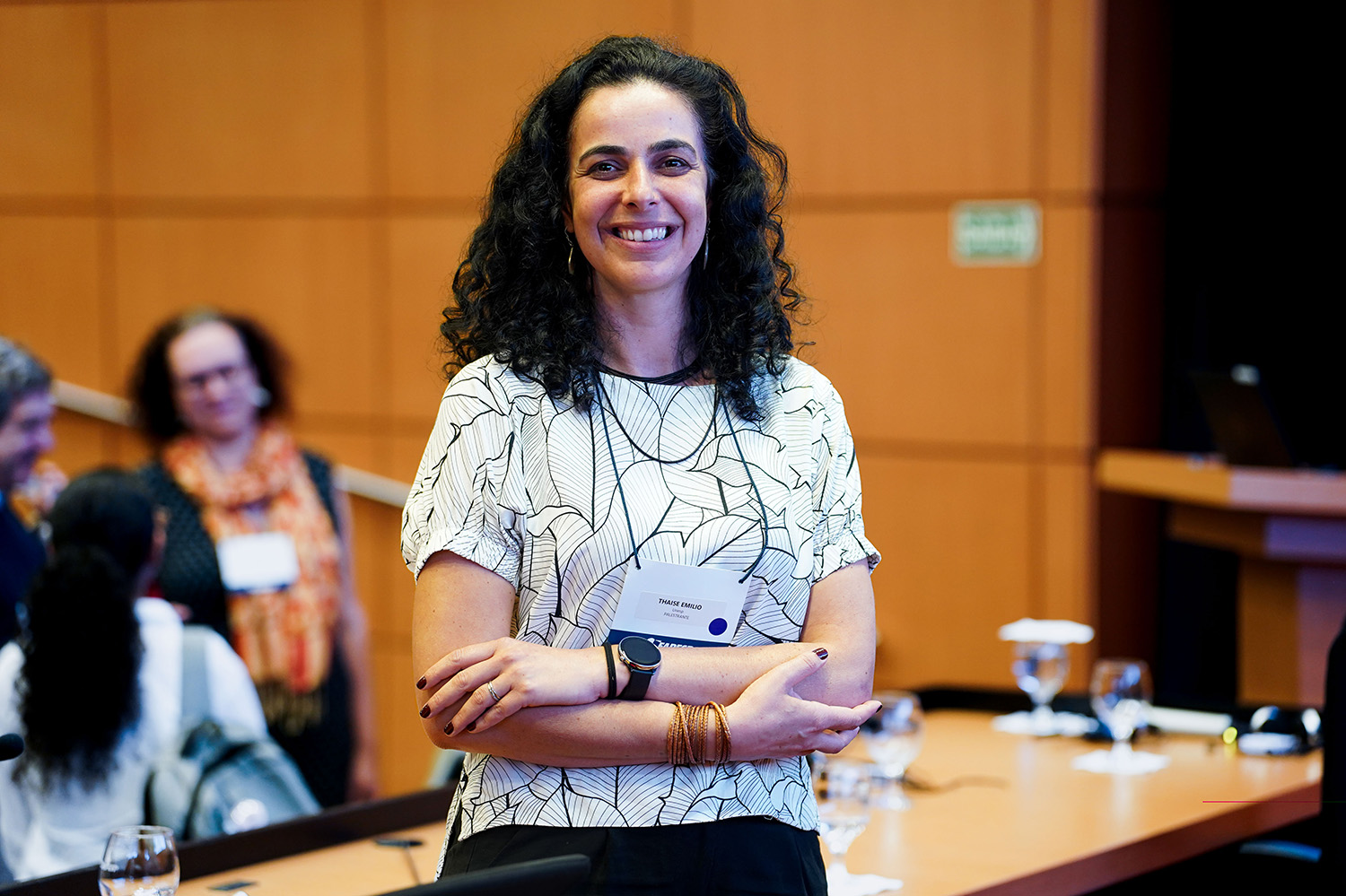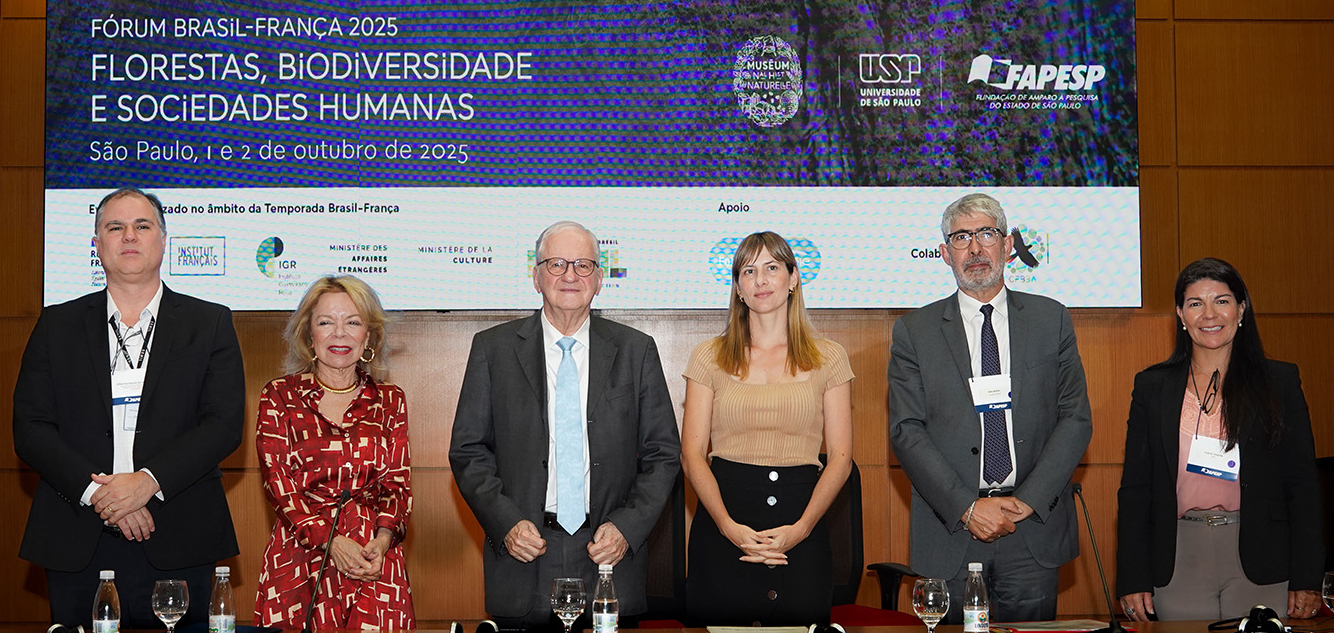

Patauá palm tree (Oenocarpus bataua) on a shoal in the Central Amazon. This species will be the next one on which researchers install sensors to estimate water storage (photo: Thaise Emilio/IB-UNESP)
The plant family can store twice as much water as trees such as ipê, mahogany, and eucalyptus, according to a study conducted at São Paulo State University. Preliminary results were presented during the Brazil-France 2025 Forum “Forests, Biodiversity, and Human Societies”.
The plant family can store twice as much water as trees such as ipê, mahogany, and eucalyptus, according to a study conducted at São Paulo State University. Preliminary results were presented during the Brazil-France 2025 Forum “Forests, Biodiversity, and Human Societies”.

Patauá palm tree (Oenocarpus bataua) on a shoal in the Central Amazon. This species will be the next one on which researchers install sensors to estimate water storage (photo: Thaise Emilio/IB-UNESP)
By Elton Alisson | Agência FAPESP – One of the most abundant plant families in the Amazon, palms (Arecaceae), can store twice as much water as dicotyledonous trees – a group of plants such as ipê (Handroanthus serratifolius), mahogany, and eucalyptus, with flowers whose seeds contain two cotyledons, which are the first “leaves” of the embryo and serve as a food source. However, the existence of these and other plant species associated with humid climates is threatened due to changes that have occurred in the hydrological cycle of the Amazon rainforest.
These findings were made through studies conducted by researchers at the Rio Claro campus of São Paulo State University (UNESP) within the scope of the Center for Research on Biodiversity Dynamics and Climate Change (CBioClima) – a FAPESP Research, Innovation, and Dissemination Center (RIDC).
Some preliminary results of the ongoing work were presented in a lecture during the Brazil-France Forum, “Forests, Biodiversity, and Human Societies”, which took place on October 1 and 2 in the Foundation’s auditorium.
The event, organized by the National Museum of Natural History (MNHN) in Paris, France; the University of São Paulo (USP); and FAPESP, aimed to discuss forest biodiversity, ecosystems, and their relationships with human societies, both past and present.
“Palm trees are large reservoirs or water tanks in the forest,” said Thaise Emilio, a professor at UNESP, project coordinator, and associate researcher at CBioClima.
Despite being only one of 171 families of tree plants in the Amazon, palm trees are extremely dominant in the forest, both in the canopy and in the understory, says the scientist.
One hypothesis explaining their dominance is that they may have been domesticated by the first human populations to occupy and manage the Amazon millions of years ago.
“There are doubts, however, as to whether it was humans who enriched the Amazon with palm trees or whether they decided to live in the forest precisely because these plants are so abundant and useful, and have great economic importance,” she pondered.
The researcher pointed out that approximately 75% of Brazil’s non-timber forest product production comes from palm trees today, with 50% coming from açaí (Euterpe oleracea) alone.

Thaise Emilio, professor at UNESP, project coordinator, and associate researcher at CBioClima. Despite being only one of 171 tree plant families in the Amazon, palm trees are extremely dominant in the forest, both in the canopy and understory (photo: Daniel Antônio/Agência FAPESP)
Drought resistance
For a long time, it was thought that palm trees were extremely vulnerable to drought due to their hydraulic architecture. To advance knowledge on this issue, the researcher began collaborating with colleagues from Soleil Synchrotron in Paris and the University of Bordeaux in 2017. Together, they analyzed the resistance of palm tree xylem to drought-induced embolism. Xylem is the vascular tissue responsible for transporting water and minerals from the roots to the rest of the plant, especially the leaves.
Drought-induced embolism is characterized by the formation of air bubbles inside the xylem vessels, which interrupts the water column and the transport of water and nutrients from the soil to the leaves. Water stress (lack of water) creates such high negative pressure that liquid water turns into gas. This impairs the function of the vessels and can lead to the death of the plant.
Using various techniques, the researchers quantified the drought resistance of six palm species belonging to the two most widely cultivated subfamilies: Arecoideae and Coryphoideae.
The observations were conducted at one of the beamlines of the Soleil Synchrotron, a circular accelerator of charged particles (electrons) that generates radiation called synchrotron light, which allows the composition and structure of matter to be investigated at the atomic and molecular scale.
“Through our observations, we found that palm trees are as vulnerable to drought as any other angiosperm [complex plants that have roots, stems, leaves, flowers, fruits, and seeds] or gymnosperm [terrestrial plants that have seeds but do not produce fruit]. But unlike other plants in temperate regions, they have more water inside their trunks. This allows them to mobilize more water, which ends up being the most important strategy for minimizing the risk of embolism,” Emilio explained.
While monitoring the amount of water stored by palm trees in partnership with colleagues from the University of Edinburgh in Scotland, the researchers recently found that dicotyledonous trees store a maximum of 50% of their water volume, while palm trees retain up to 70%. During dry seasons, palm trees reserve more water than during rainy seasons.
“This has enormous impacts on the biodiversity of the Amazon rainforest, which haven’t yet been estimated,” said the researcher.
When conducting field research in the forest during dry periods, it is common to see only fruit-bearing palm trees, she said.
“We see that only they bear fruit during these dry seasons. This is very important for maintaining the food supply for animals in the forest and for humans, who depend on these resources. And one of the hypotheses for why they’re able to maintain this service during periods of drought is precisely because they function differently from other plants, managing to store more water.”
However, this ecosystem service provided by palm trees is threatened by the decline in the abundance of plant species associated with humid climates due to the intensification of the hydrological cycle, which is characterized by more intense droughts and rainy seasons. “This will have a very important impact on the dynamics of the forest,” Emilio estimated.
In an ongoing study, the researchers have used modeling to assess the risk of palm tree mortality in different environments, such as regions with shallower or deeper water tables, and in drier or wetter years. Preliminary results indicate that palm trees would die twice as often as other trees.
“The combination of rainy and dry years is causing a change in the dynamics and characteristics of forest regions,” Emilio said.
Brazil-France Partnership
The event was part of the France-Brazil Season 2025, a program promoting cultural, scientific, and academic activities to celebrate 200 years of diplomatic relations between the two countries.
The meeting brought together scientists, artists, public managers, museum professionals, students, and representatives of civil society for conferences, roundtable discussions, and debates, as well as institutional visits.
“This event is the second part of a meeting held in June this year in Paris, which was part of the FAPESP Week program in France. Our experience on that occasion was very intense and productive in different areas, including aeronautics and space, medicine, innovation, sustainability, biodiversity, and museology,” said Marco Antonio Zago, president of FAPESP, at the opening of the event (read more at agencia.fapesp.br/54999).
Zago emphasized that the Legal Amazon, covering all the territory in the nine Brazilian states on which the Amazon biome occurs, occupies approximately 4 million square kilometers (km²) – an area roughly equivalent to 40% of Europe – but this immense forest also extends into French territory in French Guiana.
“We, Brazilians and French, therefore have a shared responsibility for this forest, which is one of the largest biodiversity reserves on the planet. Therefore, its fate may largely determine the fate of humanity,” he said.

From left to right: Jônatas Trindade, Undersecretary of the São Paulo State Department for the Environment, Infrastructure, and Logistics; Maria Arminda do Nascimento Arruda, Vice-Rector of USP; Marco Antonio Zago, President of FAPESP; Alexandra Mias, Consul General of France in São Paulo; Gilles Bloch, President of the MNHN; and Flávia Teixeira, Manager of Environment, Corporate Social Responsibility, and Energy Transition at the Engie Foundation (photo: Daniel Antônio/Agência FAPESP)
The president of the MNHN, Gilles Bloch, stated that “the environmental challenges shared by France and Brazil are very serious, and the institution is strongly committed to working on these issues in a decisive manner.”
“This forum is very ambitious and reinforces the tradition of collaboration that exists between us and USP. All the agreements we’re signing during this visit are a great honor for us and will facilitate action and cooperation in a task that needs to be carried out as a network,” he said.
Maria Arminda do Nascimento Arruda, the vice-rector of USP, announced a project currently underway to build the USP Museum Square in her speech. The square will bring together collections from the Zoology Museum (MZ-USP) and the Archaeology and Ethnology Museum (MAE-USP).
“In Brazil, natural history museums are closely linked to the emergence of scientific research in the country. The University of São Paulo has unique museum and scientific and cultural collections that are among the largest in the world. We’re committed to our museums and these collections, which is why we’re building a new space, with a remarkable design by the great architect Paulo Mendes da Rocha [1928-2021]. This new museum will be a reference for the entire city, the country, and the world,” she said.
Also participating in the opening of the event were Alexandra Mias, Consul General of France in São Paulo; Jônatas Souza da Trindade, Undersecretary of the São Paulo State Department of Environment, Infrastructure, and Logistics; Flávia Teixeira, Manager of Environment, Corporate Social Responsibility, and Energy Transition at the Engie Foundation; Carlos Graeff, CEO of FAPESP’s Executive Board; and Fernando Menezes, Administrative Director of the institution.
Republish
The Agency FAPESP licenses news via Creative Commons (CC-BY-NC-ND) so that they can be republished free of charge and in a simple way by other digital or printed vehicles. Agência FAPESP must be credited as the source of the content being republished and the name of the reporter (if any) must be attributed. Using the HMTL button below allows compliance with these rules, detailed in Digital Republishing Policy FAPESP.






